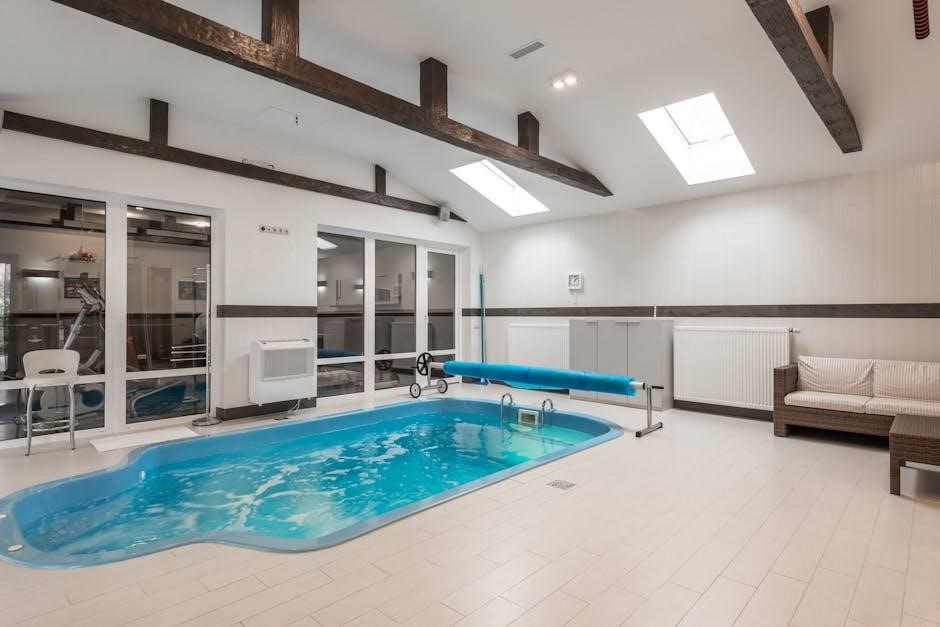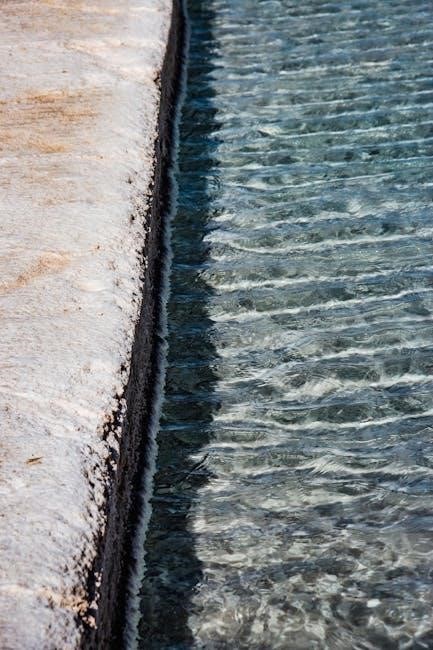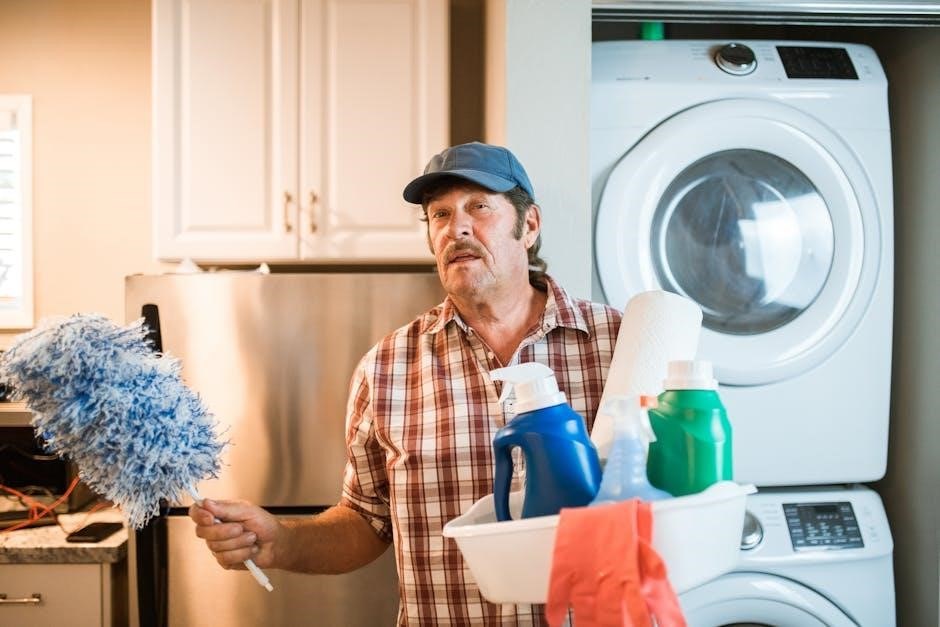Salt water pool maintenance guide pdf provides essential information on proper care and upkeep of salt water pools‚ ensuring a safe and healthy swimming environment for everyone‚ with clear instructions and tips always.
Importance of Regular Maintenance
Regular maintenance is crucial for the longevity and efficiency of a salt water pool‚ as outlined in the salt water pool maintenance guide pdf. A well-maintained pool ensures the health and safety of swimmers‚ while also protecting the pool equipment and surroundings from damage. The guide provides a comprehensive overview of the importance of regular maintenance‚ including the need to monitor and adjust water chemistry‚ clean the pool and its surroundings‚ and perform routine inspections of the equipment. By following the guide‚ pool owners can prevent problems such as corrosion‚ scaling‚ and equipment failure‚ and enjoy a safe and healthy swimming environment. The guide also emphasizes the importance of keeping records of maintenance activities‚ which helps to identify potential issues and prevent costly repairs. Overall‚ regular maintenance is essential for the proper functioning of a salt water pool.
Benefits of a Salt Water Pool
The salt water pool maintenance guide pdf outlines the numerous benefits of owning a salt water pool‚ including softer and gentler water on the skin and hair. Salt water pools are also known to reduce eye irritation and provide a more comfortable swimming experience. Additionally‚ salt water pools require less chlorine‚ which can be harsh on the skin and respiratory system; The guide notes that salt water pools are also more environmentally friendly‚ as they produce fewer byproducts and require less maintenance than traditional chlorine-based pools. Overall‚ the benefits of a salt water pool make it an attractive option for those looking for a healthier and more sustainable swimming experience. The guide provides a detailed overview of these benefits‚ helping pool owners to appreciate the value of their salt water pool and maintain it properly to ensure its longevity and efficiency.

Understanding Salt Levels
Proper salt levels are crucial for effective pool maintenance‚ requiring regular monitoring and adjustments always.
Optimal Salt Level Range
The optimal salt level range for a salt water pool is between 3200-3400 parts per million‚ as specified in the salt water pool maintenance guide pdf. This range is crucial for the proper functioning of the salt chlorinator‚ which produces chlorine to sanitize the pool. If the salt level is too low or too high‚ the chlorinator may not produce enough chlorine‚ leading to poor water quality. The salt level can be tested using salt test strips‚ which provide an accurate reading of the salt concentration in the pool. It is essential to monitor the salt level regularly and adjust it as needed to maintain the optimal range. By doing so‚ pool owners can ensure their pool remains safe and healthy for swimming‚ and the salt chlorinator operates efficiently. Regular testing and adjustments are vital to maintaining the optimal salt level range.
Testing Salt Levels with Test Strips
Testing salt levels with test strips is a simple and accurate method‚ as outlined in the salt water pool maintenance guide pdf. The test strips are specifically designed to measure the salt concentration in the pool water‚ providing a quick and reliable result. To use the test strips‚ pool owners simply need to dip the strip into the pool water and compare the color change to the chart provided. The chart will indicate the salt level in parts per million‚ allowing pool owners to determine if the level is within the optimal range. This method is easy to perform and does not require any special equipment‚ making it a convenient option for regular testing. By using test strips‚ pool owners can ensure their salt level is accurate and make any necessary adjustments to maintain a healthy and safe swimming environment. Regular testing is essential for optimal pool maintenance.

Maintaining the Salt Chlorinator
Regular maintenance of the salt chlorinator is crucial for optimal performance‚ ensuring clean and safe pool water‚ with a digital readout for easy monitoring and control always available online.
Monitoring the Digital Readout
The digital readout on the salt chlorinator provides a convenient way to monitor the system’s performance‚ displaying important information such as pool water temperature‚ current salt level‚ and purifier production level.
This information is essential for maintaining optimal pool conditions and ensuring the salt chlorinator is functioning correctly.
The digital readout also indicates when the salt level is low‚ providing a warning to add more salt to the pool.
By regularly monitoring the digital readout‚ pool owners can identify potential issues before they become major problems‚ saving time and money on repairs.
The digital readout is typically easy to read and understand‚ making it a valuable tool for pool owners of all experience levels.
Overall‚ monitoring the digital readout is a crucial part of maintaining a salt water pool‚ and it helps to keep the pool clean‚ safe‚ and healthy for swimmers.
The digital readout is an important feature of the salt chlorinator‚ and it plays a key role in maintaining optimal pool conditions.
Temperature Compensation Feature
The temperature compensation feature is a valuable aspect of the salt chlorinator‚ allowing it to adjust its performance based on the pool water temperature.
This feature is essential for maintaining optimal chlorine production‚ as the temperature of the pool water can affect the chlorinator’s efficiency.
The temperature compensation feature ensures that the chlorinator produces the correct amount of chlorine‚ regardless of the water temperature.
This helps to maintain a safe and healthy swimming environment‚ while also preventing over-chlorination or under-chlorination.
The feature is typically automatic‚ eliminating the need for manual adjustments.
By compensating for temperature fluctuations‚ the feature helps to reduce the risk of algae growth and other problems.
The temperature compensation feature is a key component of the salt chlorinator‚ and it plays a crucial role in maintaining optimal pool conditions.
It is an important consideration for pool owners‚ and it can help to ensure a safe and enjoyable swimming experience.

Weekly Maintenance Routine
Regular tasks include skimming and vacuuming to keep the pool clean and safe always.
Pool Usage and Environmental Factors
The frequency of maintenance tasks depends on various factors‚ including pool usage and environmental conditions‚ such as weather and surrounding vegetation. A busy pool with many swimmers requires more frequent cleaning and maintenance to prevent the growth of bacteria and algae. Environmental factors‚ such as heavy rainfall or strong winds‚ can also impact the pool’s condition‚ requiring additional maintenance tasks to ensure the water remains safe and clean. By considering these factors‚ pool owners can adjust their maintenance routine to meet the specific needs of their pool‚ ensuring a healthy and enjoyable swimming environment. Regular monitoring of the pool’s condition and adjusting the maintenance schedule accordingly is crucial to prevent problems and maintain the pool’s overall health. This helps to identify potential issues early on and take corrective action to prevent more serious problems from developing.
Balancing Water Chemistry
Properly balancing the water chemistry is crucial for maintaining a safe and healthy swimming environment. This involves monitoring and adjusting the levels of various chemicals‚ such as pH‚ alkalinity‚ and calcium hardness‚ to ensure they are within the recommended ranges. A balanced water chemistry helps to prevent corrosion‚ scaling‚ and staining‚ while also protecting the pool equipment and surrounding structures. Regular testing and adjustment of the water chemistry is necessary to maintain the optimal balance‚ and this can be done using a variety of testing kits and equipment. By following the guidelines outlined in the salt water pool maintenance guide pdf‚ pool owners can learn how to properly balance their pool’s water chemistry and maintain a safe and healthy swimming environment. This is an essential part of salt water pool maintenance and should be done on a regular basis to prevent problems and ensure the pool remains in good condition.

Consulting a Pool Professional
Consulting a pool professional is highly recommended for salt water pool owners who are unsure about any aspect of maintenance or repair. A professional can provide personalized advice and guidance on how to properly care for the pool‚ including information on the latest technology and equipment. They can also help to identify and fix any problems that may arise‚ and provide recommendations for improving the overall performance and efficiency of the pool. By consulting a pool professional‚ owners can ensure that their pool is well-maintained and safe for use‚ and can also help to prevent costly repairs and replacements. When selecting a pool professional‚ it is essential to choose someone who is experienced and knowledgeable about salt water pools‚ and who can provide expert advice and guidance on all aspects of pool maintenance and repair‚ as outlined in the salt water pool maintenance guide pdf.


